"The
two off-duty watches were hanging around not knowing what to do. I came
across two ratings of my mess, Mess 32. They were regulars that could
not read, write or swim and had been in the navy since the age of
twelve and I never saw them again. I worked my way to the bow and
befriended a regular Royal Navy AB who threw a rope over the bow and
said 'The next torpedo and over I go.' He didn't have long to wait. A
third torpedo hit and most of the crew abandoned ship as word was
passed round by word of mouth. The Able Seaman said he would go over
first. I lowered myself into the water to find him waiting. Then we
both waited for my friend to enter the water. He panicked screaming
that he could not swim and would not let go of the rope. After twice
swimming back the AB told me to leave him.
We swam into the night with little idea
of the time which passed before
Venomous
came into view and stopped to pick up a float full of men; she
misjudged, hitting the float, spilling men either side of the ship. We
swam to the nets on the stern and hung on exhausted. There came a voice
from the bridge shouting 'Let go aft I have a ping'. The seamen on
Venomous told us to jump off the
net and most of us did but I hung on and so did the AB behind me.
Venomous
took off dragging us in the net. How long I was in the net I do do not
know. After screaming out I was untangled, dragged onboard and thrown
on deck. Afterwards thrown into the hammock rack in the seamen's mess
deck to recover.
When I came to I found myself lying alongside the
seaman friend that had panicked and refused to let go of the rope on
Hecla. He was raving mad, nobody
could do anything for
him. We were told to leave him, he would recuperate. At first light I
was helping to clear up the mess on the quarter deck near the nets when
they pulled a body out of the nets. It was the able seaman I had spent
the night with."
Jack Bolton remembered this incident vividly:
"With
Venomous at a standstill I was sent down on deck to help in the rescue. The men clutching the
scrambling nets hung over the stern were so thick with oil it was
almost impossible to haul them to safety. An officer on the bridge
called out that they had a ping on the ASDIC and we should "let
go". A seaman slipped from my hand, fell backwards with his feet
tangled in the net and I heard the terrible sound of his head
repeatedly hitting the ship's hull as Venomous accelerated away in pursuit of the prowling U-boat."
Jack Bolton, who tried to pull the AB aboard described what happened when Venomous accelerated away in pursuit of the U-boat.
Burial at Sea
By mid afternoon HMS
Venomous
was almost out of fuel and ignoring orders to head for Gibraltar just
managed to make it to Casablanca soon after its capture by
American forces. After two nights in Casablanca
Venomous left on the 14 November for Gibraltar and four of the survivors who had died after rescue were sewn into canvas
hammocks, weighted with shells at their feet and buried at sea from the stern
. Cyril Hely
photographed the burial and wrote on the reverse: "
Thomas
Luxton, George Taylor, Charles Odey and Alfred Dutton were buried at
sea at latitude 34 degree 30 minutes North and longitude 7 degrees 30
minutes west."
Lt Cdr "Harry" Alexander RN, the Navigating Officcer on HMS
Hecla, read the brief service.
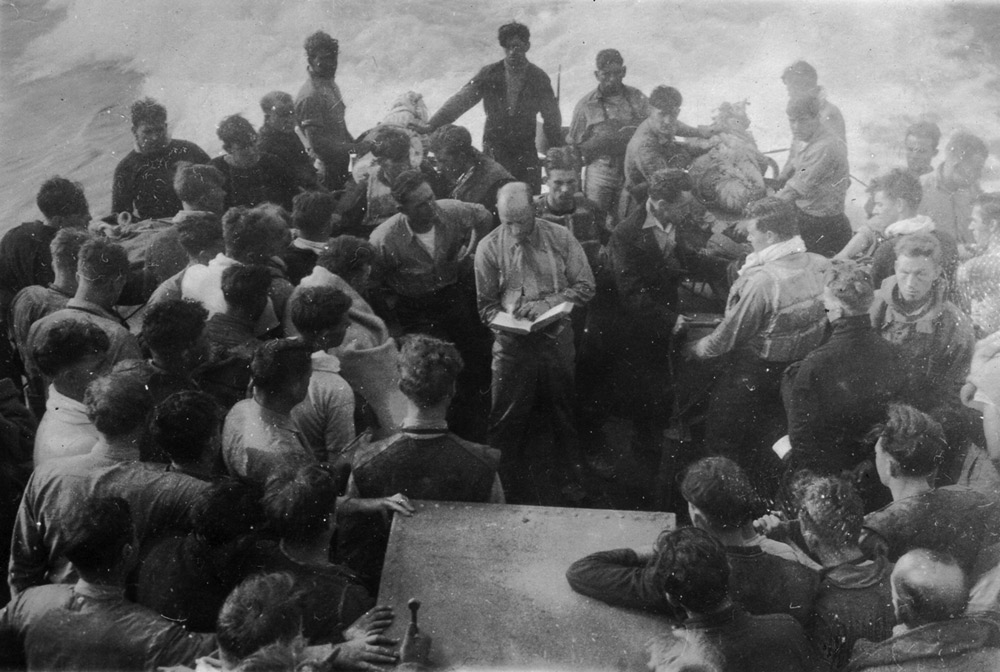
After arrival at Gibraltar another four survivors who died from their
wounds were taken out to sea on a barge with volunteers from
Venomous to bury them. The
bodies of Jabez Skelhorne, Charles
Stocker and Albert Thick were washed ashore on
the Moroccan coast and
now lie in
the Santa Catalina cemetery in the Spanish enclave of Ceuta.
The grandsons of Albert Thick and
Jabez Skelhorne
spent years uncovering the story of how they died and Simon Skelhorne
arranged for their graves to be restored by the Commonwealth War Graves
Commission.
After survivor's leave Les
Mortimer was sent on a course at the Whale
Island Gunnery School and then joined the LCT (Landi0ng Craft Tanks)
being built for the Normandy landings. AB Leslie Mortimer served on
LCT-703 which made thirteen trips to the Normandy beach heads. After
the war he worked at Austin Motors' Longbridge plant at Oxford before
emmigrating
to Australia in 1948. Les is 89 and lives in an outlying district of
Melbourne where his children and grand children live.
I
am indebted to Julie Nestic, the grand daughter of Les Mortimer, for having supplied the
photographs and a typescript of this brief memoir he wrote in 1998.
His
service certificate and other documents can be downloaded as a PDF from Australia's Department of Defence web site
AB Charley Stocker J17615
Les Mortimer did not remember the name of the AB he swam with that night
but he was old for a rating, perhaps in his forties, and called
'Charley'. There are two Able Seamen (AB) called Charley on the short
list of men who died aboard HMS Venomous.
Most of those who died that night were
reported as "missing presumed killed"
Only the living were brought aboard Venomous
and only those who died after rescue and were buried at sea were
reported as "killed'
Charley Stocker who lived for a day or two after being rescued and was
buried at sea at Gibraltar but washed ashore and buried a second time
in the Santa Catalina Cemetery in Ceuta, came from Blandford in Dorset
and at 46 was prfobably the oldest man on the lower deck of HMS Hecla, "AB
Charles Stocker
(D/J17615), aged 46, son of John
and Alice Stocker and husband of Minnie Stocker of Blandford,
Dorsetshire" (Commonwealth War Graves
Commission).
Charles William Odey was only 33, the son of Thomas Job and
Mary Agnes Patrick Odey, of Buckland, Portsmouth.Les
Mortimer described "at first light I was helping to clear up the mess
on the quarter deck near the nets when they pulled a body out of the
nets. It was the able seaman I had spent the night with." He was buried at sea
off the stern of HMS Venomous
while enroute from Casablanca to Gibraltar and his name is on the
Portsmouth Naval Memorial on Southsea Common.
This leaves the identity of the AB who helped save Les Mortimer and became entangled in the scrambling net as Venomous accelerated away in pursuit of the U-boat open to doubt but the story of Charley Stocker is told below.
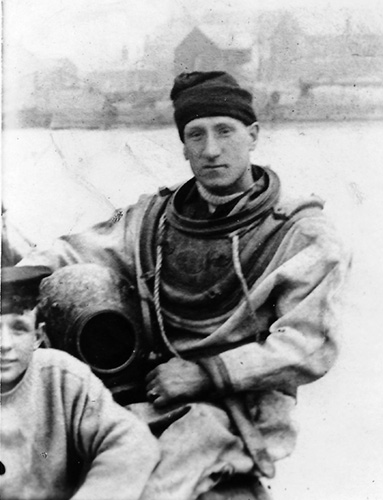
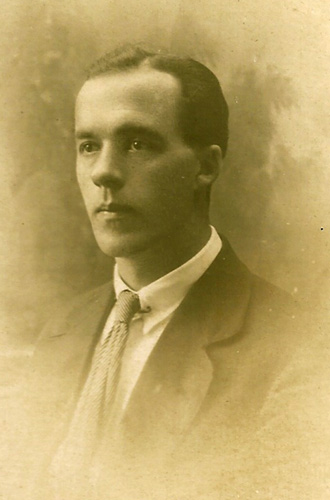 Charley - not Charles -
Stocker was born at Uplyme near Lyme Regis on the Devon Dorset border
on the 28th June 1896 and was probably the oldest rating in Hecla when she was torpedoed. He left school at 14 and went into domestic service at the nearby village of Whitchurch Canonicorum.
Charley - not Charles -
Stocker was born at Uplyme near Lyme Regis on the Devon Dorset border
on the 28th June 1896 and was probably the oldest rating in Hecla when she was torpedoed. He left school at 14 and went into domestic service at the nearby village of Whitchurch Canonicorum.
He was a Boy Sailor at HMS Impregnable, a training ship at Devonport (replaced by HMS Ganges) from May 1912 to January 1913 and on the Dreadnought Battleship HMS Bellerophon (1907). When he signed on for twelve years on his 18th birthday his service record gave his occupation as farm labourer and noted that he had tattoos on both arms. He was rated Ordinary Seaman (OD) and AB (Able Seaman) while serving in Bellerophon.
He joined the Battleship HMS Revenge on 1 February 1916 and took part in the Battle of Jutland on 31 May. On the 1st December 1917 he joined her sister ship, HMS Resolution but returned to Revenge on 4 March 1918.
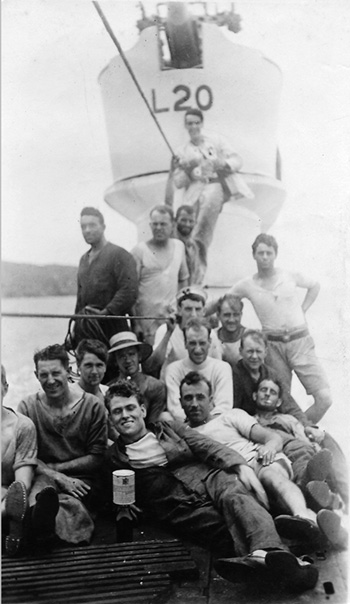 |
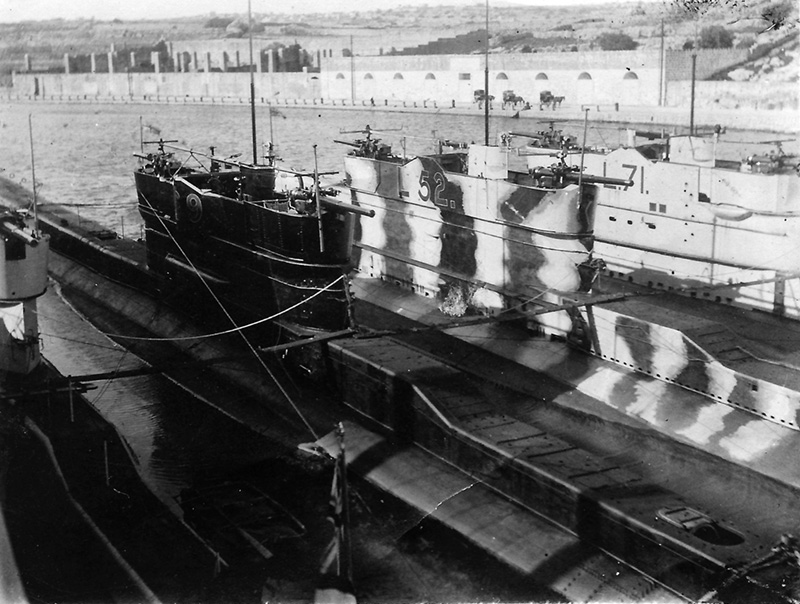 |
All the photographs on this page are from the album of Anne
Stocker, Charley Stocker's elder sister (by an earlier marriage), and
were scanned and sent to me by her grandson, Peter Bellinger, who was
tracing his family's history and became interested in how his Great
Uncle came to be killed when HMS
Hecla was torpedoed 75 years ago this year.
The portrait top left is the only known photograph of Charley Stoker
(signed, "with best wishes your service chum" on reverse) and the diver is Charles Wallace Mitchell with Fort Blockhouse at the
entrance of Portsmouth harbour behind. Charles Mitchell served on the
submarine depot ship
HMS Titania
when she was based at Hong Kong in the 1920s. The submarine L20 was one
of her charges and was photographed in the Matsu Islands, five miles
from the coast of China in the Taiwan Strait, in July 1920. The
logbooks of the
Titania can
be viewed on the web and record several trips from Hong Hong to Matsu,
the L20 submarine and the use of divers. The Stocker and Mitchel
families were from the Axminster area and Charles Mitchell married
Charles cousin on his Mother's side, Lilly Augusta. The large
photograph of submarines was taken at Malta on 3 November 1925 and
incribed by Charles Mitchel on the reverse "My work as a Jazz
artist". In 1925 Charley Stocker was in HMS
Queen Elizabeth, the Flagship of the Mediterranean Fleet, which was based in Malta and they were bound to have met.







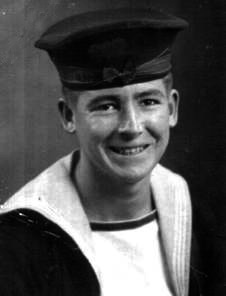
 Leslie
Mortimer was born at Kings Norton, Birmingham, on the 24 November 1923
and trained as a bench fitter (drilling machine operative). He gave his
mother as his nearest relative when he enlisted in the Royal Navy aged
eighteen in December 1941.
Leslie
Mortimer was born at Kings Norton, Birmingham, on the 24 November 1923
and trained as a bench fitter (drilling machine operative). He gave his
mother as his nearest relative when he enlisted in the Royal Navy aged
eighteen in December 1941. 
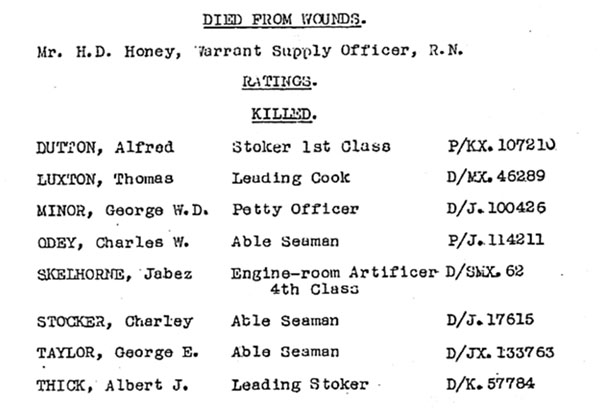

 Charley - not Charles -
Stocker was born at Uplyme near Lyme Regis on the Devon Dorset border
on the 28th June 1896 and was probably the oldest rating in Hecla when she was torpedoed. He left school at 14 and went into domestic service at the nearby village of Whitchurch Canonicorum.
Charley - not Charles -
Stocker was born at Uplyme near Lyme Regis on the Devon Dorset border
on the 28th June 1896 and was probably the oldest rating in Hecla when she was torpedoed. He left school at 14 and went into domestic service at the nearby village of Whitchurch Canonicorum. 

